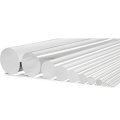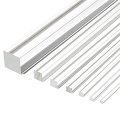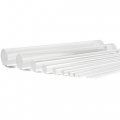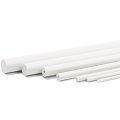ASA & Polystyrene Rods
Information about rods made of ASA and polystyrene
Applications: The polystyrene strips from the American company Evergreen are cut from sheets. As a result, they have sharp edges and are true to size.
The PS strips are great for model making because of their straightforward workmanship and high quality. They are also very popular for use in building model railroads and dioramas. In architectural model making they can be used to represent window frames or structural components of the façade.
Treatment: Making your own GRATING FRAMES out of polystyrene strips is a reasonably priced alternative to the more expensive injection moulded ones. In doing so, you should attach an adhesive tape strip on your worktable with the sticky side up (or simply use a double-sided tape), then mount the strips to these and glue them as needed with dichlormethane or plastic glue. After allowing the adhesive tape to dry it should be removed by pulling it away at an oblique angle. Profiles with T or I or other cross-sections can be created on your own by employing a template (the gluing should be done dichlormethane).
If solvent (e.g. dichlormethane) is used, polystyrene can be glued to itself so that there is practically no trace of the gluing to be seen. In doing so, the two assembly components should be held together, the liquid should be applied to the interstice with a brush and then simply wait a short time. The solvent seeps into the joint and etches the plastic and the pieces then stick to one another. Other plastic glues like Ruderer plastic glue can be used to glue PS to PS but the resulting seams are not nearly so fine.
Solvents can also be used to glue polystyrene to other plastics such as acrylic glass, polycarbonate, PET-G or ABS. Plastics that are not soluble or which only have low solubility can be glued to polystyrene with Ruderer L 530 or other plastic glues.
Non-plastic materials can be glued to PS with Ruderer plastic glue, UHU Hard, contact glues like Pattex Transparent or with cyanacrylate glues (super glue).



